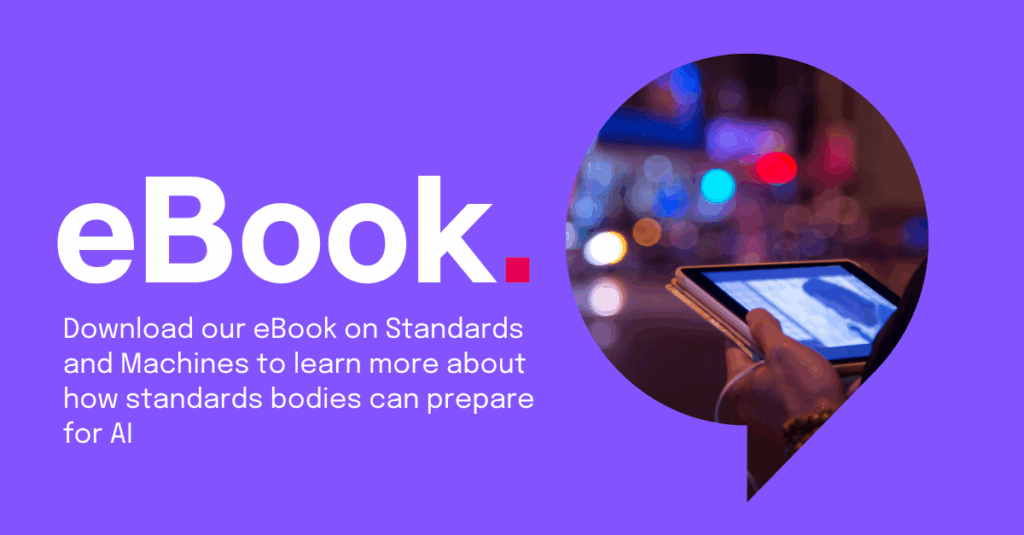The New Era of Digital Trust and Intelligent Content
Standards bodies and accreditation organizations are moving beyond paper-based publications and manual review processes into a new era of digital trust and intelligent workflows.
A clear example is the ANSI National Accreditation Board (ANAB) and its Digital Technology Initiative (DTI). This program aims to harmonize digital service delivery and strengthen engagement with clients, scheme owners, and regulators. At the center is an AI Task Force, established to explore how artificial intelligence can improve accreditation processes, enable continuous monitoring, and deliver secure, digital accreditation certificates that inspire confidence.
This kind of initiative signals a wider shift across the standards community—toward connected, data-driven ecosystems where information flows freely and securely. To make this possible, standards content must evolve. Instead of being trapped in static documents, it should be managed as structured, modular data that machines can interpret and reuse accurately.
Recent analysis from the OECD’s report on “Enhancing Access to and Sharing of Data in the Age of Artificial Intelligence” underscores this imperative, actively promoting the findability, accessibility, interoperability and reusability of data and data quality, as AI becomes more integrated into processes.
In short, digital trust now begins with how content is created. Standards organizations that modernize their authoring and publishing workflows—and ensure their materials are both human- and machine-readable—will be best placed to lead in an AI-driven world.
The Role of Structured, Modularized Content in an AI-First World
From Documents to Data
Traditional document-based publishing locks valuable knowledge inside formats that AI tools can’t easily process. By contrast, modular authoring breaks standards into smaller, well-defined units, like clauses, definitions, and procedures, that can be managed and updated individually. This approach turns standards into living data assets that remain accurate and adaptable over time.
Enabling Machine Understanding
When standards are modularized, they become interoperable across platforms and systems. This allows AI to cross-reference requirements, identify relationships, and support compliance activities without guesswork. Structured, modular data reduces ambiguity, making standards safer for automated use in technologies such as knowledge graphs, regulatory engines, and retrieval-based AI tools.
Streamlining Collaboration
Modularization also improves teamwork. Authors and reviewers can work within familiar Microsoft 365 environments, updating specific sections while maintaining a single, consistent source of truth. Changes cascade automatically across all related publications, saving time and ensuring alignment.
Building for Interoperability
As the World Wide Web Consortium (W3C) observes, semantic data structures enable information to be linked, shared, and reused across applications and communities. For standards bodies, structured and modular content is both efficient and ensures interoperability in a digital and AI-enabled ecosystem.
Connecting Standards, Data, and AI Through Intelligent Systems
The next step for standards and accreditation bodies is connecting modular content with wider digital environments—accreditation data, legislation, and compliance systems.
When standards are managed as modular, machine-readable data, they can link directly to accreditation workflows. This makes it possible for AI to trace relationships, verify compliance, and identify gaps or overlaps automatically. The result is a more transparent, data-driven network where content and accreditation processes work together seamlessly.
The ANAB Digital Technology Initiative shows how this transformation is already underway, with digital certificates, harmonized workflows, and continuous monitoring driving greater confidence in accreditation. To achieve similar results, standards content must be semantically rich and interoperable, allowing machines to understand and trust each requirement.
Connected data ecosystems are key to trustworthy AI. Modular authoring provides the foundation for that connection—linking people, processes, and intelligent systems within a unified ecosystem of digital trust
Building the AI-Ready Standard: What Standards Bodies Should Know
As AI reshapes how information is created and consumed, standards organizations have an opportunity to lead with confidence. Becoming AI-ready means transforming standards into structured, modular data that can move freely between systems while retaining accuracy and authority.
By adopting modular authoring, organizations strengthen version control, enable traceability, and create a sustainable model for reuse across platforms. This approach not only improves internal efficiency but also establishes standards bodies as trusted sources of verified knowledge in an increasingly automated world.

